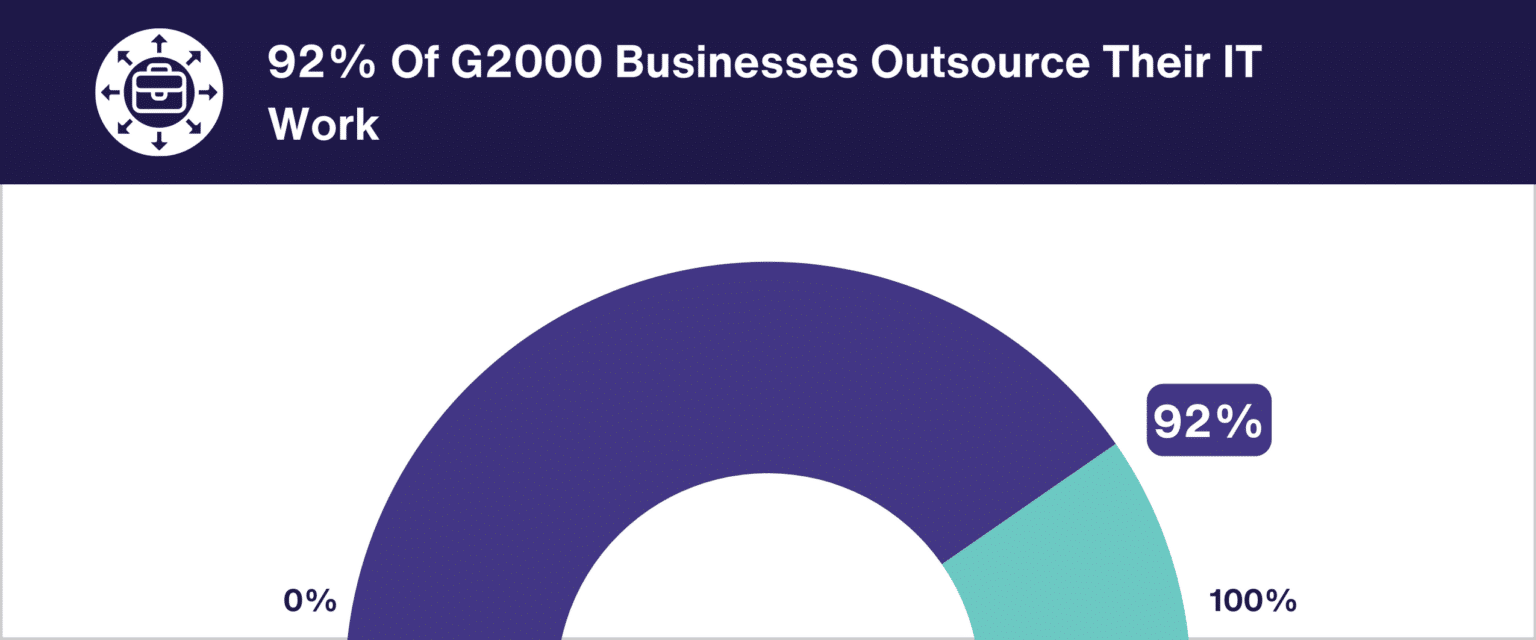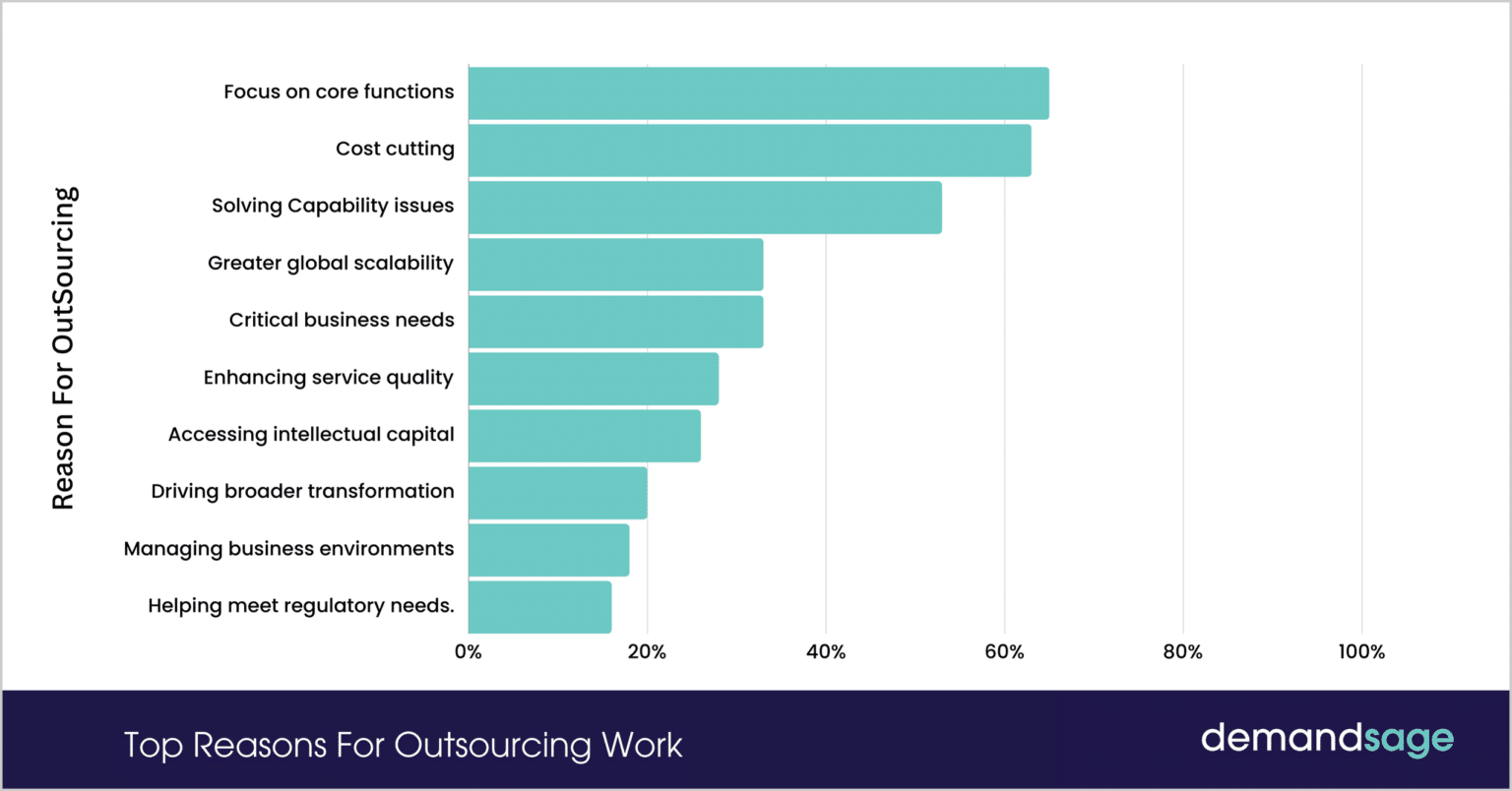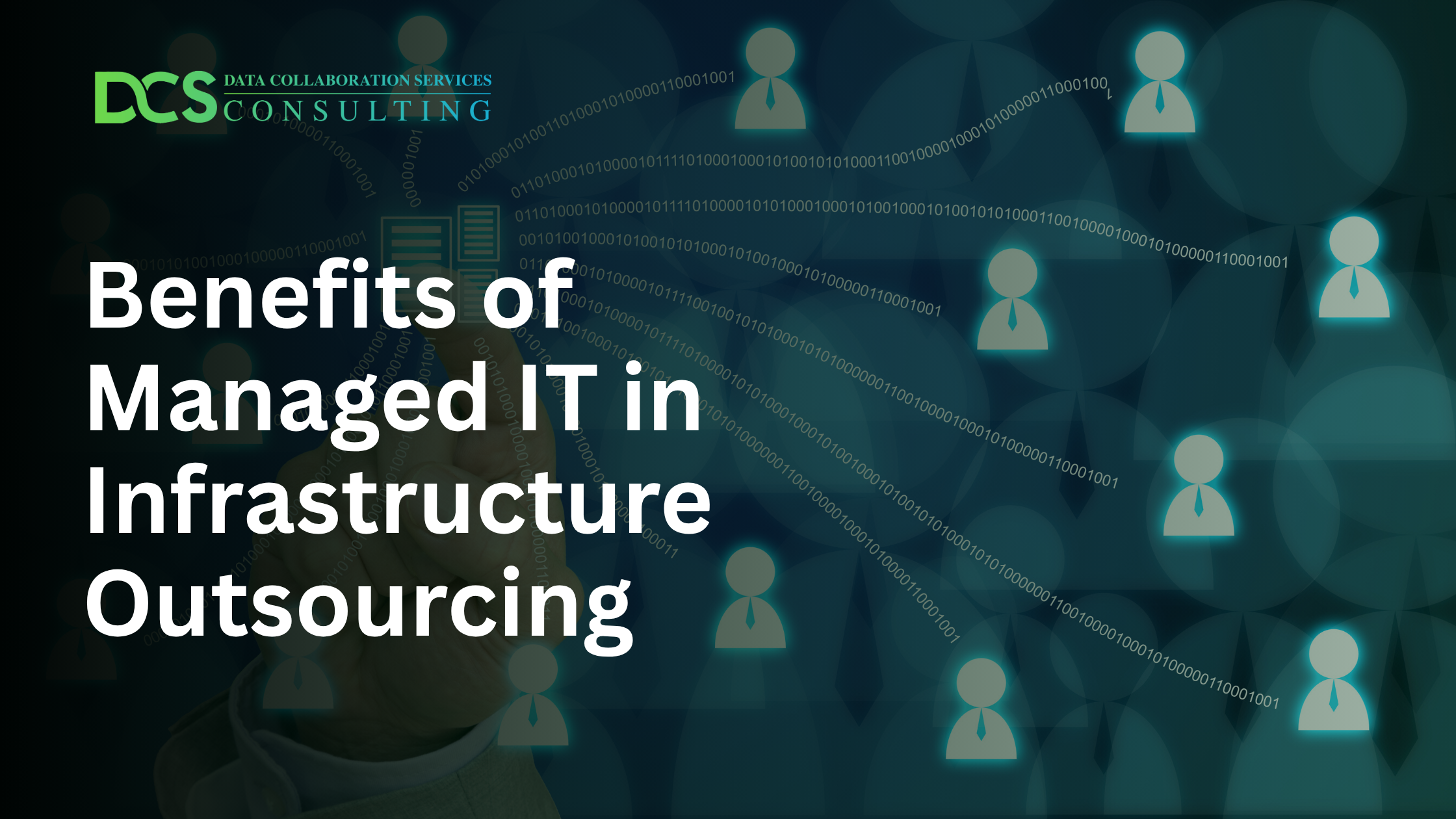The Truth About IT Outsourcing (That No One Tells You)
Let’s be honest, most companies don’t plan to outsource IT infrastructure because it sounds glamorous. They do it because something broke, someone panicked, and “just call an MSP” suddenly became the office mantra.
And honestly? It’s not a bad move.
According to a report, more than 90% of G2000 businesses outsource some part of their IT infrastructure, and see 30% lower operational costs on average. But the funny thing is, not all outsourcing is created equal. Without managed IT support, outsourcing can turn from a smart business move into an operational disaster.

Source: Demandsage
Stick around as we unpack why managed IT support is the unsung hero in the IT outsourcing landscape.
What Is IT Infrastructure Outsourcing?
Think of IT infrastructure outsourcing like adding muscle to your business without the heavy lifting. It’s when a company hands off part (or all) of its IT operations like servers, storage, networks, and security systems to a trusted external provider.
The goal is to free up time, save money, and tap into expert-level IT management without the payroll bloat.
Most businesses opt this because:
- Their internal IT team is drowning in helpdesk tickets.
- They need 24/7 coverage but can’t justify hiring a night crew.
- Technology keeps evolving faster than their team can keep up.

Source: Demandsage
Why Managed IT Support Is the Secret Sauce
Imagine outsourcing your IT infrastructure like sending your car to a garage, but without a mechanic who checks under the hood regularly? That’s where managed IT support swoops in like a superhero. It’s not just babysitting your systems; it’s proactive IT support that keeps everything running like a well-oiled machine.
Here’s how managed support turns outsourced chaos into streamlined control:
Proactive Monitoring & Maintenance
Most IT disasters don’t happen overnight. They build up quietly, a missed patch here, a full server there until suddenly, boom: downtime.
Managed IT support brings proactive monitoring to the table. Instead of waiting for something to break, systems are monitored 24/7. Threats are flagged. Glitches are fixed. Updates happen on time (not three months after your vendor remembers).
According to IBM’s Cost of a Data Breach Report, companies with proactive monitoring save an average of $1.76 million per breach compared to reactive ones.
In short, managed IT support doesn’t wait for fires. It prevents them.
Enhanced Security Measures
Cybercriminals aren’t picky. They’ll go after anyone with weak passwords, outdated firewalls, or unpatched software.
With outsourced IT infrastructure, your data lives in multiple environments, which can be a hacker’s dream if not managed properly. That’s where managed support flexes its muscles.
At DCS, we implement advanced tools like SentinelOne, SonicWall, and Microsoft Defender, pair them with multi-factor authentication (MFA), and back it all up with real-time threat monitoring.
Because if there’s one thing scarier than a cyberattack, it’s explaining to your clients why their data is on the dark web.
Scalability & Flexibility
Your business isn’t static and neither should your IT be.
One of the biggest perks of outsourced IT infrastructure is scalability. Managed support takes that up a notch. Need to onboard 50 new employees next quarter? Easy. Moving operations to the cloud? Done. Shrinking your footprint after a restructure? No problem.
Managed IT support lets you scale resources up or down instantly. No hiring freezes, no hardware headaches, no drama.
Benefits of Combining Managed IT Support + Outsourced Infrastructure
Alright, let’s talk results. When you combine managed IT support with outsourced infrastructure, here’s what happens:
Cost Efficiency
Goodbye, unpredictable IT bills. Hello, predictable pricing. Outsourcing eliminates big capital expenses, no more buying servers that’ll be obsolete in three years. Instead, you get fixed monthly costs that cover everything from maintenance to security.
According to a report, businesses save an average of 25–45% on IT costs through outsourcing and managed services. That’s money you can reinvest into growth.
Access to Expert Talent
Let’s face it: finding good IT talent is hard. With managed support, you get instant access to a team of certified pros who live and breathe IT. They’re up-to-date on the latest trends, security threats, and tech innovations, so you don’t have to be. No hiring. No training. IT expertise, on demand.
Improved Business Continuity
Downtime doesn’t just hurt, it bleeds money. Managed IT support ensures your outsourced infrastructure comes with disaster recovery plans, automated backups, and redundant systems that keep your business running, even when the unexpected hits.
Because when a storm takes out your main data center, you want backups ready, not excuses.
Choosing the Right Managed IT Support Partner
How do you find a provider who won’t ghost you when things go south? Here’s your shortlist:
- Experience: Look for providers who’ve worked across industries and understand your specific IT environment.
- Certifications: Think Microsoft Partner, ISO 27001, or equivalent cybersecurity credentials.
- SLAs (Service Level Agreements): Make sure that SLAs guarantee uptime and response times.
- Reviews & References: Ask for testimonials or case studies. A confident provider will be happy to show results.
- Alignment: The best MSPs don’t just fix problems, they align IT strategy with your business goals.
At Data Collaboration Services (DCS), our managed IT support services don’t just keep your systems running, but keep your business thriving.
Takeaway: Outsourcing Works, If You Manage It Right
Outsourcing your IT infrastructure can feel like handing over your car keys. But with managed IT support, you’re not giving up control, you’re gaining it.
You get proactive monitoring, top-tier security, expert strategy, and the freedom to focus on what actually grows your business.
At Data Collaboration Services, we’ve helped hundreds of small and mid-sized businesses streamline their IT operations. Whether you’re scaling fast or just tired of putting out IT fires, we’ve got your back.
Ready to trade tech headaches for peace of mind? Let’s take your IT from chaos to chill.
Talk to our managed IT expert today.
FAQs
1. What is IT infrastructure outsourcing?
IT infrastructure outsourcing is when a company transfers its IT services including servers, storage, network management, and other IT operations to an external provider.
2. How does managed IT support enhance outsourcing?
It adds proactive monitoring, maintenance, and cybersecurity — preventing issues before they impact operations.
3. Is outsourcing secure?
With the right provider (and regular audits), outsourced infrastructure can be more secure than in-house systems.
4. How much can I save?
Most businesses save between 25–45% in IT costs by outsourcing and using managed services.
5. Can small businesses benefit?
Absolutely, managed IT support is especially valuable for SMBs that want enterprise-level reliability without enterprise-level expenses.
6. What are the potential risks of outsourcing IT infrastructure?
Potential risks include security vulnerabilities, loss of control and vendor lock-in.
7. How does outsourcing IT infrastructure impact business continuity?
Outsourcing IT infrastructure helps ensure business continuity by providing disaster recovery plans, automatic backups, and redundant systems. A managed IT provider can quickly restore operations in case of a system failure or cyberattack, minimizing downtime and data loss.
8. What is the cost difference between in-house and outsourced IT infrastructure?
Outsourcing IT infrastructure typically offers cost savings due to reduced overhead expenses. In-house IT requires hiring, training, and retaining IT staff, as well as maintaining hardware and software. Outsourcing, on the other hand, offers a predictable monthly cost, eliminating the need for capital investments and emergency IT costs.
9. How can businesses measure the success of outsourced IT infrastructure services?
Businesses can measure the success of outsourced IT infrastructure services by tracking uptime and system availability, cost savings and return on investment (ROI), security performance (number of threats mitigated, incidents avoided), User satisfaction and scalability.


